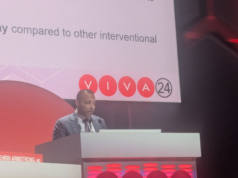Here is a personal view by Roger Greenhalgh about the management of varicose veins. It comes from a vascular surgeon who has spent most of his operating life working on arterial reconstruction, and, latterly, with the endovascular opportunities to correct both arterial and venous problems.
Wherever a massive incision could be replaced by a smaller one, or by no incision, it soon became apparent that the patient preferred the lesser procedure. Just imagine what it was like before Dr Tom Fogarty’s balloon catheter for arterial embolectomy!
During the arterial endovascular revolution, there have been changes in the way varicose veins are managed.
Until recently, surgery was the mainstay of treatment. The surgeon had reduced the size of incisions and very good cosmetic results have been achieved. There has been some discussion as to whether recurrence was inevitable or the result of poor technique at the time.
A view has emerged, in the last five years, certainly, that varicose veins can be managed conveniently in an office-based environment.
The value of tumescent anaesthesia seems to be the key. With the patient awake, the vein surrounds are anaesthetised under duplex imaging control.
This surgeon-friendly system of ultrasound is easy to learn and enables the operator to infiltrate the vein bed along the whole length under consideration.
Tissues are lifted away from the vein and the incompetent vein can be occluded by the use of either radiofrequency or laser. Both produce heat. This is not felt by the patient, but enough damage to the vein wall occurs to make the walls stick together when bandaged.
It is a feature of this “office-based” varicose vein correction that the main incompetent vein is treated, rather than all branches.
The operator sees the patient later, to see if injection of residual veins is needed.
Some do veins under general anaesthetic and do a more complete job, including branches.
Perforating veins can also be targeted by radiofrequency and laser.
There is a view that surgery to the main incompetent trunk is bound to carry the risk of recurrence. It is said that crossectomy is an encouragement of neorevascularisation or regrowth of tiny veins. So, it is not just that office-based venous ablation is preferred by patients, it is argued that it is likely to be more durable.
My personal view is that the follow-up times are too short to tell at this stage, but I am impressed by tumescent anaesthesia and radiofrequency.
Dr John Bergan of San Diego is a very prominent venous specialist and has a distinguished arterial career behind him. He has adopted office-based vein practice virtually completely for some years, but with a difference.
Dr Bergan favours foam sclerotherapy ahead of other methods.
He is convinced that it is but a matter of time before foam sclerotherapy will be the accepted method.
Why does he think this? He stresses that foam finds its way into, not just the main trunk, but branches as well. He says it is usually the branches that cause the trouble and does not hold with the view that ablation of the main trunk only is enough.
The FDA has not granted a certificate for foam, and I understand it has been turned down more than once.
I have even heard panellists tease Dr Bergan that he will expect to defend himself in court.
Why the divergence of opinion? There are instances of embolistion occurring after foam sclerotherapy, and, of course, if there is a patent foramen ovale, this could cause a stroke – hence the fear.
But Bergan insists that the full protocol should be followed, and this includes a longish period of elevation of the injected leg to 45 degrees. He says this makes it safe, but, to say the least, it remains controversial.
My personal view is that Dr Bergan could be right and a safe and excellent result could occur from well-trained use of foam.
However, there are no rumblings of concern with laser or radiofrequency, and at this moment, these techniques are gaining ground, while only a few enthusiasts use foam.
Though polydocanol injections are used by many to tidy up little offending veins, and it is essentially the same agent used as foam.
We cannot predict where this will end, but it is a fascinating field and never more interesting than now, when such excellent methods are vying for supremacy.
I am not quite sure which will be the winner, but the leader is radiofrequency at this moment, though I do not rule out an eventual domination by foam sclerotherapy.
Time will tell.
Have your say on the future of foam sclerotherapy.
“In the USA, as Roger Greenhalgh states, the FDA has not granted a certificate for foam. Therefore, the use of foam sclerotherapy can subject a physician to litigation.However, like many areas of medicine, with different modalities to treat the same ailment, a physician should select the best treatment for the given ailment. As we go forth in the USA, I believe that foam sclerotherapy will be considered the standard of care for treatment of neovascularisation, truncal veins (GSV, SSV, junctional tributaries, etc) less than 10mm, and other ultrasound-guided sclerotherapy. Once there is a FDA-approved foam sclerosant and insurance carriers and ’medicare’ reimbursement, then we will see rapid adoption of the procedure.” – Lowell S Kabnick, New York University Vein Center, USA
“Yes! I have been using STD foam for a number of years now, on hundreds of branch varicosities and truncal veins with excellent results once the pigmentation and lumpiness settle down, either post EVLA and as a stand alone treatment. I have had one (albeit dreadful) DVT in a fit young man with a huge incompetent accessory LSV where I used 3% STD.” – Rhoda MacKenzie, Aberdeen, UK
“If it is the case that radiofrequency is winning the battle, much of this is down to clever marketing (e.g. exaggerating the difficulties of laser regulations) and the fact that most of the doctors prescribing this treatment are not responsible for the costs involved in administering it. Radiofrequency is a much more expensive treatment than either laser or foam. This problem is compounded by some laser manufacturers trying to compete more effectively with radiofrequency by solving “problems” that don’t really exist in the UK (e.g. patent infringements on medical techniques, and the “difficulties” of local anaesthetic infusion). This then makes the major name lasers far more expensive than they need to be.” – David West, Surgilas Ltd, UK
“I think Prof Greenhalgh has, as usual, made a good and timely resume of the actual situation with radiofrequency being the preferred method, and with laser almost succeeding in proving itself as equally good. In our ABC, foam is now routinely used for recurrences in the groin after classical stripping where it simplifies treatment and avoids a cumbersome dissection of the femoral vein that could be the etiology of a new neovascularisation process. For foam treatment of the saphenous vein, we don’t like the 20% early recanalisations, the discoloration of the skin and the unacceptable cerebral complications, although we realise that they are very rare.” – Jacques Bleyn, Antwerp, Belgium












